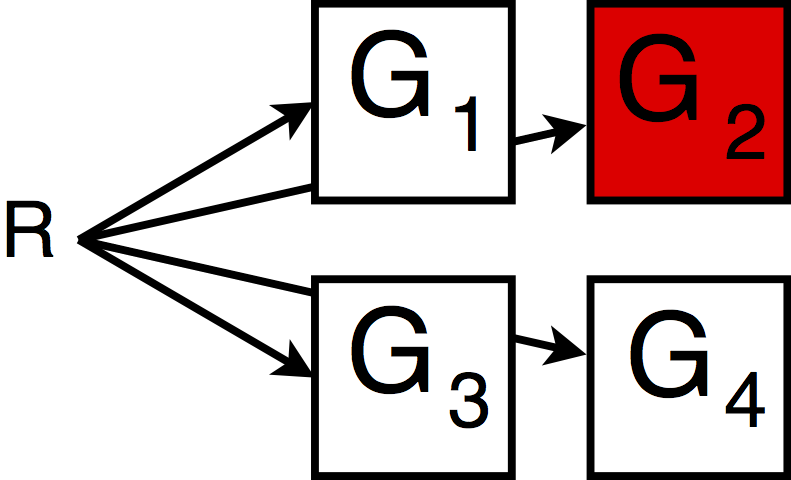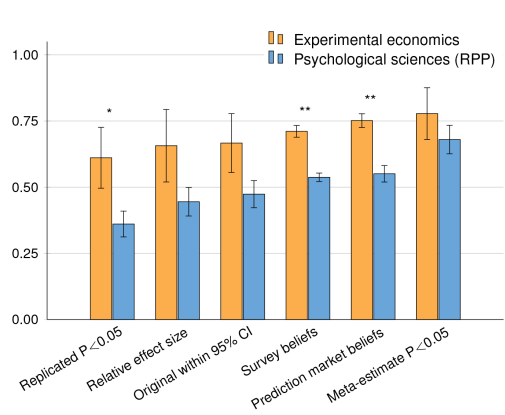
A z-Tree Course
1: Introduction to Experiments in Economics
Matteo Ploner
Università degli Studi di Trento
Making Inferences
Causal Inference
- Knowledge progresses by finding causes of phenomena
- e.g., Human activity $\Rightarrow ? \Rightarrow$ global warming
 from "An Illustrated Book of Bad Arguments" by Ali Almossawi
from "An Illustrated Book of Bad Arguments" by Ali Almossawi
Hypothesis Testing

- A description of Theories, Phenomena, and Data (Guala, 2005)
- Theories explain Phenomena
- Phenomena organize data that are messy, suggestive and idiosyncratic
- Data do not need a theoretical explanation, while phenomena do
- Distinction between data and phenomena: two stages of scientific research
- Phase 1: data are organized to identify phenomena
- Phase 2: causes of a phenomena are organized into theories
Perfectly Controlled Experimental Design (PCED)
- A Perfectly Controlled Experimental Design (PCED) represents in an abstract fashion the best way to test causal relations (Guala, 2005)
- A PCED is built around comparison and controlled variation
- Comparison → groups that have been exposed to different conditions are juxtaposed
- Controlled variation → all factors that are not intentionally manipulated should be kept constant across groups (uniformity)
Controlled Variation
- How to obtain a controlled variation?
- Matching
- Units that are identical are assigned to groups in different conditions
- Consider a response variable $Y$
- $Y_t(u)$ is the value of the response that would be observed if the unit were exposed to $t$
- $Y_t(u)-Y_c(u)$ is the causal effect of $t$ (relative to $c$) on $u$
- Causal inference refers to the appraisal of $Y_t(u)-Y_c(u)$
- Fundamental Problem of Causal Inference: it is impossible to observe the value of $Y_t(u)$ and $Y_c(u)$ on the same unit and, therefore, it is impossible to observe the effect of $t$ on $u$
Controlled Variation (ii)
- How to obtain a controlled variation?
- 2. Randomization
- The random assignment of units to groups in different conditions makes the groups identical in expected terms

The identification framework (Newey, 2007)
- $Y_{i1}$ is the observed outcome for subject $i$ who is exposed to the intervention ($D_i=1$)
- $Y_{i0}$ is the observed outcome for subject $i$ who is NOT exposed to the intervention ($D_i=0$)
- The outcome $Y$ for individual $i$ is thus $Y_i=Y_{i0}+(Y_{i1}-Y_{i0})D_i=\alpha_i+\beta_iD_i$, with $\alpha_i=Y_{i0}$ and $\beta_i=Y_{i1}-Y_{i0}$
- The average tretament effect (ATE) is the average of the slope ($\beta$) over the entire population
- This is generally what the experimenter is interested in
- The average tretament effect on treated (ATT) is the average of the slope ($\beta$) over the population of treated ($D_i=1$)
The identification framework (Newey, 2007)
- If
- the mean of $Y_{i1}$ does not depend on the treatment status ($E[Y_{i1}|D_i]=E[Y_{i1}]$)
- and
- the mean of $Y_{i0}$ does not depend on the treatment status ($E[Y_{i0}|D_i]=E[Y_{i0}]$)
- → $ATE=ATT=E[\beta_i]$
- This condition holds when individuals are randomly assigned to treatments
- Being assigned to a treatment does not depend on the output variable $Y_i$
- In field happenstance data, it is likely that $E[Y_{i}|D_i]\neq E[Y_{i}]$ (self selection into a treatment)
- Solved econometrically via instrumental variables or other "selection on observables" techniques.
Models of Experimental Design
- Basic models of experimental design (guala, 2005)
- Post-test
- The (causal) effect is given by $Y_{G_1}-Y_{G_2}$
- Pre-test/post-test
- The (causal) effect is given by $(O_{G_2}-O_{G_1})-(O_{G_4}-O_{G_3})$ (diff in diff)
- The Pre-test/post-test allows to control for the impact of measurement


Experimental Economics
Why Running Economic Experiments?
- Roth (1995) identifies 3 main motives for experiments in Economics
- Speaking to Theorists
- Testing predictions originating from formal theories
- The organization of empirical regularities into formal theories
- Searching for Facts (Meaning)
- The study of effects that are not (yet) part of a well-structured theory
- The accumulation of facts that may lead to the creation of new theories (``Searching for Meanings'')
- Whispering to the Ears of Princes
- The formulation of advices for policy makers
Methodological Issues
- Hertwig and Ortmann (2001) identify 4 essential methodological aspect of experiments in economics
- Script Enactment
- Comprehensive instructions reduce risk of ``demand effects''
- Favors replicability
- Repeated trials
- Allows for learning and, potentially, equilibrium convergence
- Performance-based monetary payments
- Proper monetary payments allow to control for the disturbance due to cognitive effort
- Deception
- Deception may induce suspicion among participants and generate uncontrolled reputation spillovers
Validity of Experimental Findings
- Methodological aspect affect the validity of the experiment
- The validity of an experiment can be assessed along two dimensions
- Internal validity
- The extent to which an experiment allows to draw inferences about the behavior in the experiment
- External validity
- The extent to which an experiment allows to draw inferences about behavior outside the experiment
Internal Validity
`Just as we need to use clean test tubes in chemistry experiments, so we need to get the laboratory conditions right when testing economic theory'' (Binmore, 1999)
- To ensure internal validity a proper experimental setting should be implemented
- Examples of dirty tubes
- Bad incentive schemes
- Individuals self-select into treatments
- Deceitful instructions
- Experimenter effects
- Reputation (supergames)
External Validity
- 3 dimensions of artificiality that may impact on external validity of experiments (Bardsley et al., 2010)
- Artificiality of isolation
- The experimental setting may omit relevant features of the external environment
- Findings in the lab may not survive when transferred to the complexity of the real-world
- Artificiality of omission and contamination
- The laboratory environment may bias results (e.g., bad incentives)
- A lack of internal validity produces a lack of external validity
External Validity (ii)
- 3. Artificiality of alteration
- The laboratory alters natural phenomena
- Individuals attach a different meaning to a market in the laboratory and to a real stock market $\rightarrow$ it is impossible to study stock markets in the laboratory
- Artificiality of alteration is the most challenging
Building Blocks
Building Blocks
- Repetition
- One shot vs. repeated trials
- Stationary repetition, conditional task, ...
- Payment scheme
- Random lottery incentive, cumulative payment ...
- Choice Task (stage game)
- Roles, action space, ...
- Matching
- Partner matching, absolute stranger, perfect stranger, ...
Repetitions
- One-shot: the stage game is repeated only $1 \times$
-
Round ID 1 101 102 103 104 - Repeaterd trials: the stage game is repeated $N>1 \times$
-
Round ID 1 101 102 103 104 2 101 102 103 104 3 101 102 103 104 ... 101 102 103 104 - Repetitions can be
- Stationary: same task over distinct rounds
- Dynamic: different tasks over distinct rounds
Incentive-compatibility
- Motivation of participants is controlled via (monetary) rewards $\Rightarrow$ Induced Value Theory (Smith, 1976)
- 3 qualifications of the postulate
- Subjective costs (values) may be non-negligible and interfere with monetary reward
- e.g., cognitive effort may overcome the monetary incentives
- A game value may be attached to experimental (nominal) outcomes (e.g., points or tokens)
- As long as the value function is monotone it does not interfere with induced valuation (reinforcement)
- Individuals may be concerned with others' utility and thus not be independent in their evaluation
- Increasing one's own payoff not necessarily increases utility (e.g., equity concerns)
Payment schemes
- Different payment schemes could be adopted when repeated choices are collected
- Cumulative payment
- All choices are rewarded
- Random Lottery Incentive (RLI)
- One choice is randomly chosen for payment
- Chosen round is communicated to participants only at the end of the expeirment
- The RLI mechanism generates incentive compatible choices as long as participants are EUT
-
It avoids potential confounds due to wealth effects or edging wrt cumulative payment
Choice Task
- Aspects of the choice task that need to be carefully defined
- Roles in the interaction should be assigned to participants
- Usually roles are randomly defined by randomly assign participants to computer terminals
- Action space
- The action space affects the nature of the outcome variable
- Dichotomous data, Count data, Continuous data, String data
- Payoff rule
- Must produce incentive compatible choices
- Important to check that participants understood it
- When tokens are employed a conversion rate should be specified
Data Independence
- Statistical tests should be run on independent observations
- The outcome of one observational unit should not be affected by the outcome of another observational unit
- When choices of one participant interact with choices of another participant their choices are no more independent
- The contagion analogy
- This is true even when the interaction is indirect but mediated by a bridging individual

An Example
| Round | ID | |||
|---|---|---|---|---|
| 1 | 1 | 2 | 3 | 4 |
| 2 | 1 | 2 | 3 | 4 |
- 4 players interact in groups of 2 over two rounds
- Blue and Red
- Thus, the following connections are created
-
ID 1 2 3 4 1 1 2 1 1 3 1 0 1 4 0 1 1 1 - 3 and 2 are not directly connected, but indirectly (via Pl. 4)
- Only one independent observation in the experiment!
- Average choice of the four players
Matching Protocol
- 16 Participants
- ID: 1, 2, ... 16
- 4 groups
-

- Blue, Red, Orange, Green
- 4 rounds
- Round 1, Round 2, Round 3, Round 4
- Each group has 4 participants
Partner Matching
- 4 participants interact in the 4 rounds
-

- Players 1-4 are always in the same (blue) group
- Reutation building
Random Partner Matching
- Each group is made of 4 participants and participants in a group interact together
- At each repetition the groups are formed randomly
-

- e.g., player 1 is in group Blue in rounds 1--3 and in group Green in round 4
- Two players can be matched together in different rounds
- e.g., 1 and 9 are in the same group in rounds 1 and 4
- PRO: simple to implement and to explain; control on reputation concerns
- CONS: the number of independent observations is endogenous and shrinks with repetitions
Random Partner Matching with Matching Groups
- 4 groups: Blue, Red, Orange, Green
- The groups are matched into two subgroups
- [Blue, Red] and [Orange, Green]
- Each group is made of 4 participants and participants in a group interact together
- In each repetition the groups are formed randomly, within the subgroups
-

- Participants in the two subgroups never meet $\Rightarrow$ segregation
- A way to increase the number of independent observations with random matching
Absolute Stranger Matching
- Two participants never meet twice
-

- PRO: Perfect control about reputation concerns
- CONS: Observations are not independent
- Everyone meets everyone
Stages of an Experiment
- Design
- The building blocks should meet research hypotheses
- Repetitions, Payment scheme, Choice task, Matching
- Useful to discuss the design in internal seminars
- Recruiting of participants
- Usually participants are registered in a database (e.g., ORSEE)
- Participation to the experiment is solicited via emails or posters
- Conductance of the experiment
- Participants are gathered in a room (laboratory) and asked to make their choices
- Computerized or paper & pencil
- Data analysis
- Data are collected, organized and analyzed
- Focus on hypotheses testing
State of the Art
Experimental Economics

- The number of publications referring to "Experimental Economics" has grown rapidly
Replications
- Experiments can be replicated (unlike field happenstance data)
- Most journals publish details about procedures and instructions
- Reproducing results is key to the credibility of the discipline
- Two studies present evidence of reproducibility of results
- In economics (Camerer et al, 2016)
- In psychology (Open Science Collaboration, 2015)
Replicability of Economic Experiments
- Camerer et al. (2016) autonomously replicate 18 experimental studies published in AER and QJE
-

- Significant effect like the original in 11 out of 18 (61.1\%)
Replicability of Economic Experiments (ii)
- Camerer et al. (2016) compare their results to those of Open Science Collaboration (2015) in Pychology
-

- According to Camerer et al. (2016) the better relative performance of Economics may be due to
- Monetary incentives and truthful information
- Instructions and data are routinely published with the paper
-
Evaluate 100 studies and replicate
36\% of them
